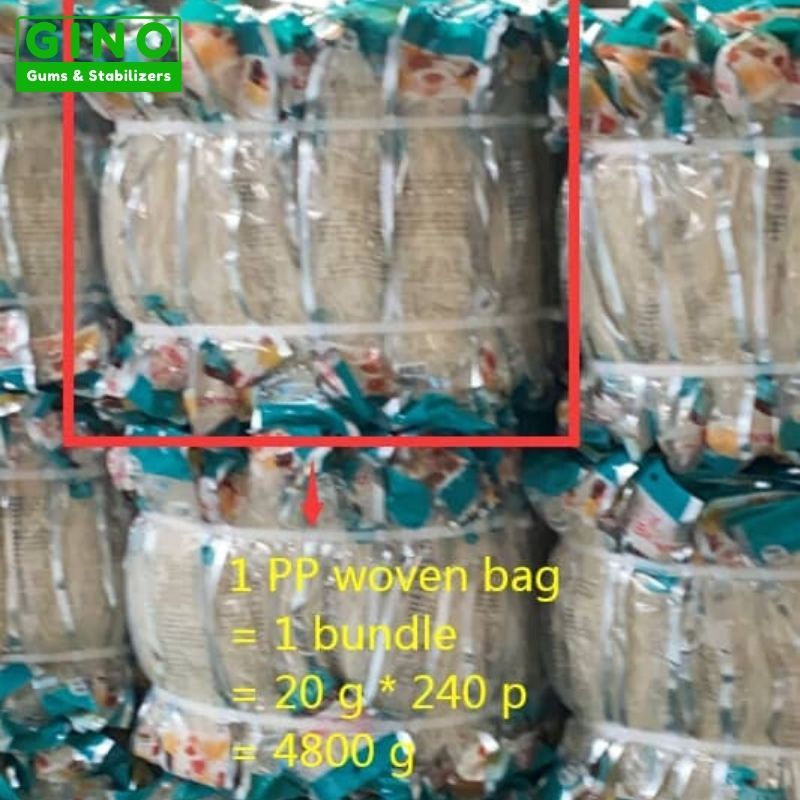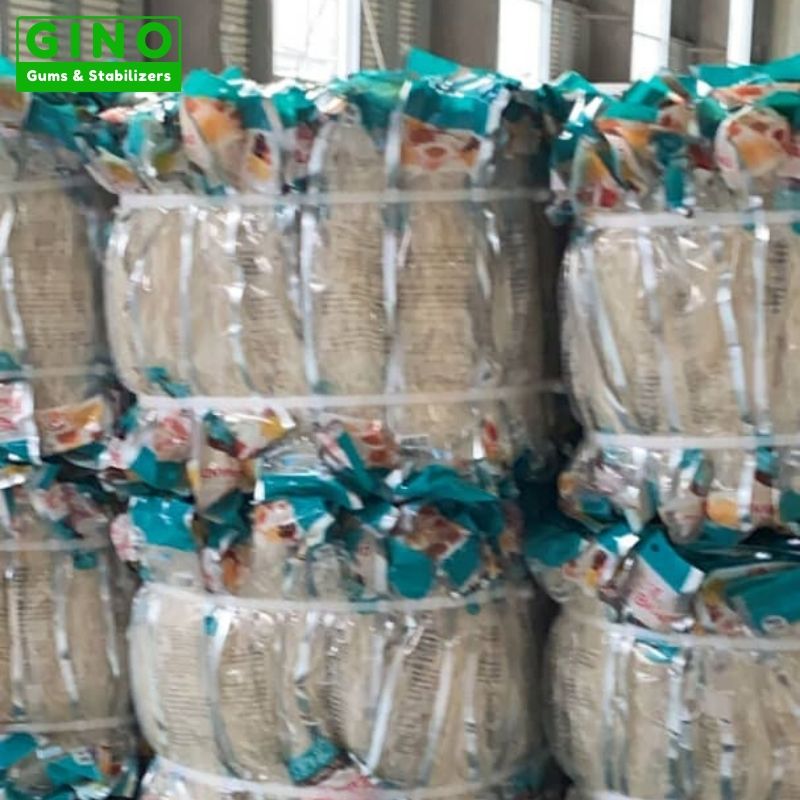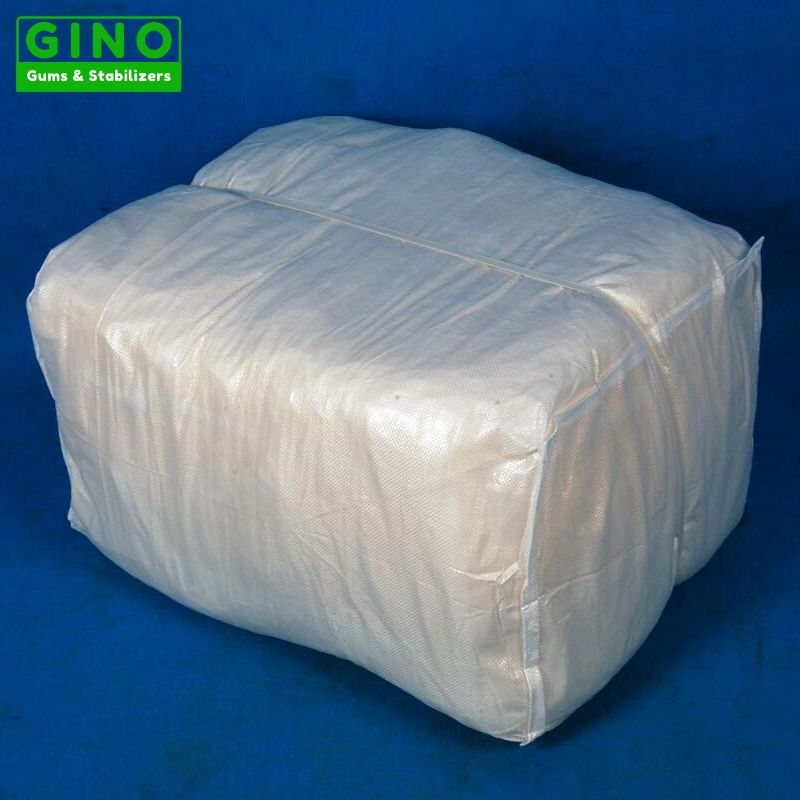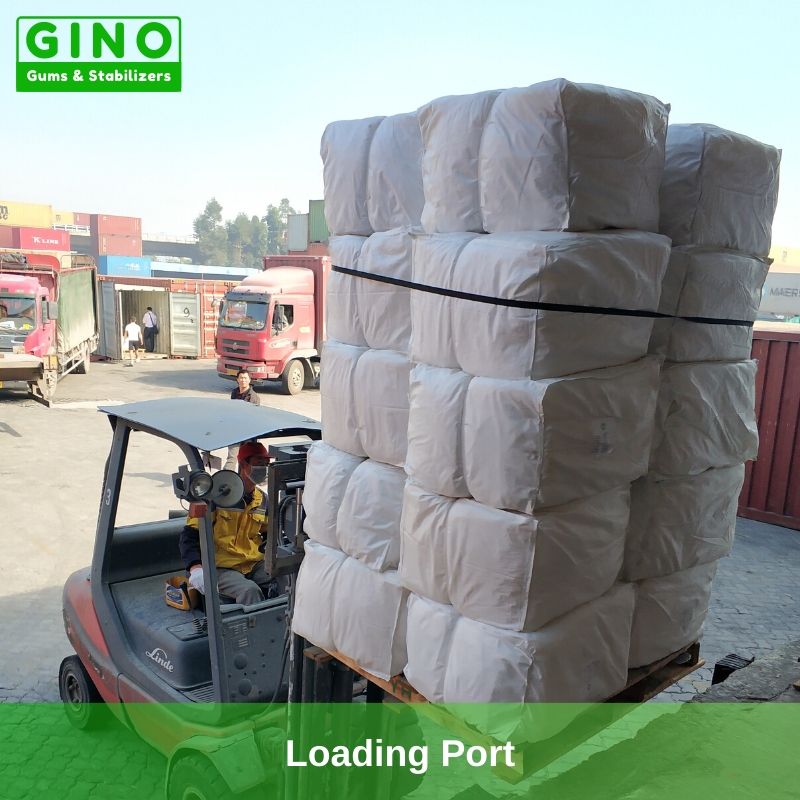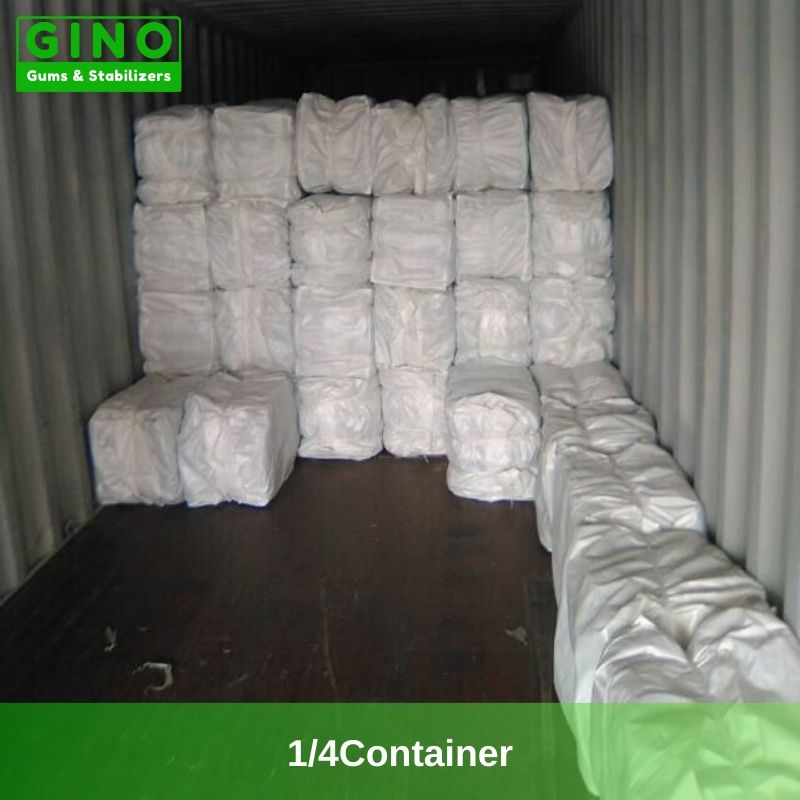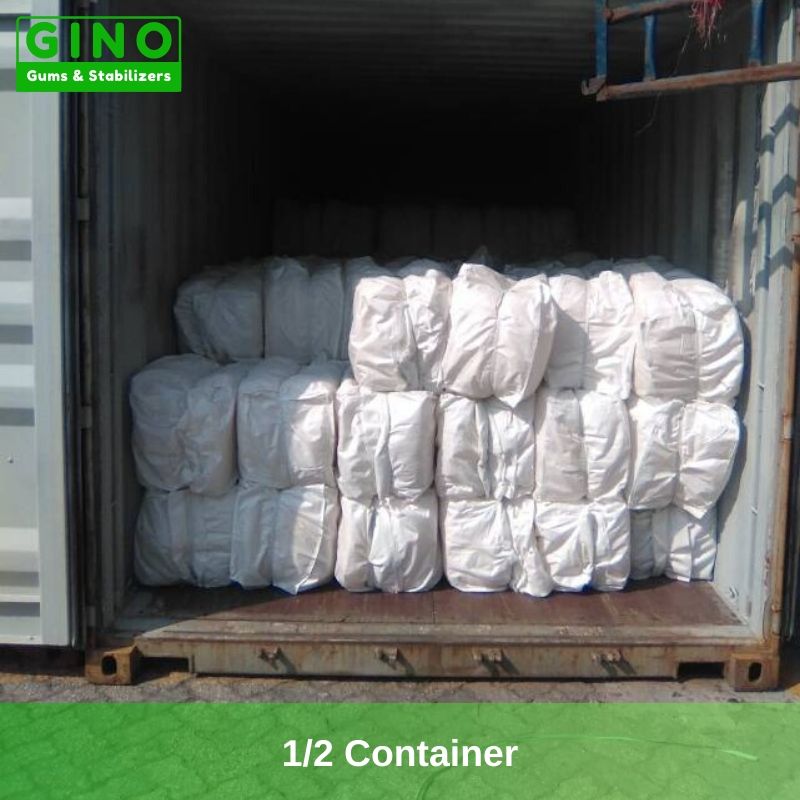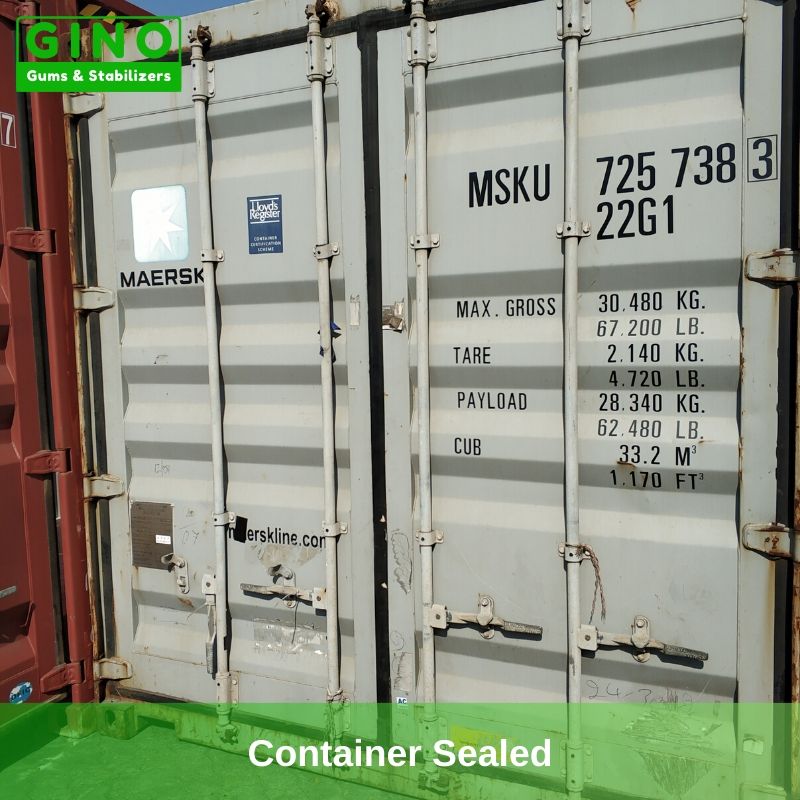Tiras de ágar-ágar
O que é Agar Agar
O ágar-ágar é um hidrocolóide de algas marinhas, ou ficocolóide, com uma longa história de utilização como aditivo alimentar gelificante, espessante e estabilizador. É considerado a goma hidrocolóide natural mais forte, e também o substituto perfeito para a gelatina de origem animal.
Como um dos fabricantes, fornecedores e exportadores profissionais de ágar-ágar na China, a Gino dedica-se a fornecer-lhe produtos superiores de fabricantes fiáveis de ágar-ágar. Com a nossa variedade de sistemas de gelificação/estabilização, podemos criar soluções personalizadas perfeitamente adaptadas a todas as suas necessidades.
Contacte-nos para saber mais sobre uma única goma hidrocolóide ou sobre estabilizadores alimentares (misturas e sistemas) que possam funcionar para os seus produtos. Se tiver alguma questão, não hesite em enviar um e-mail para [email protected].
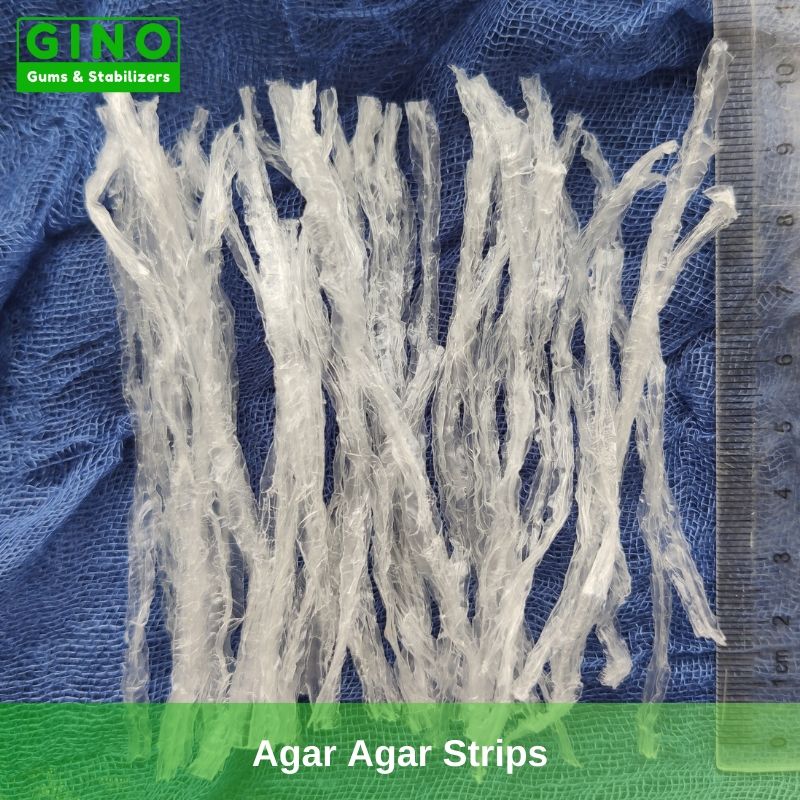
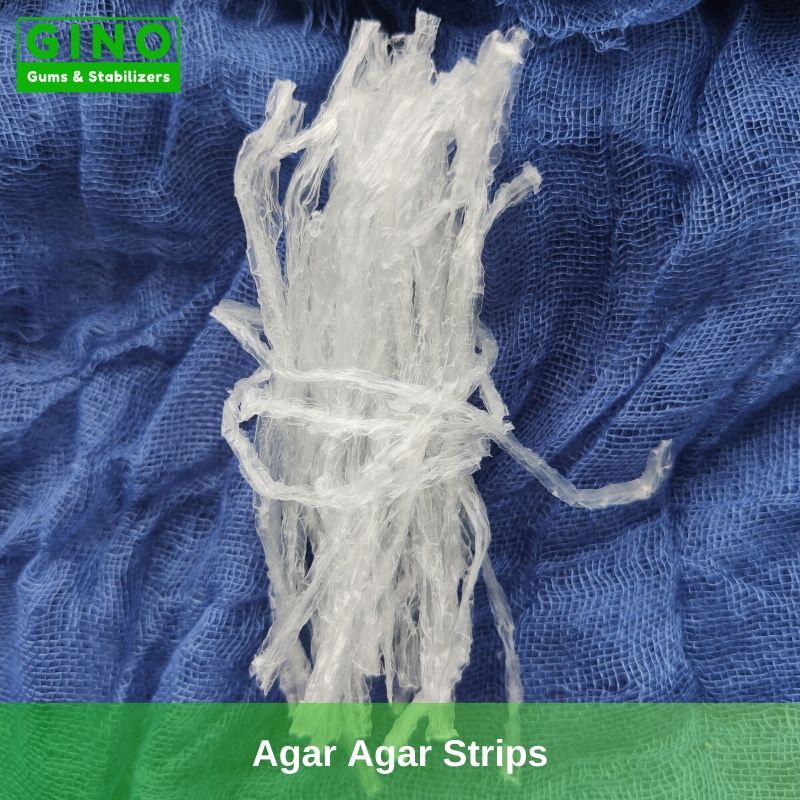
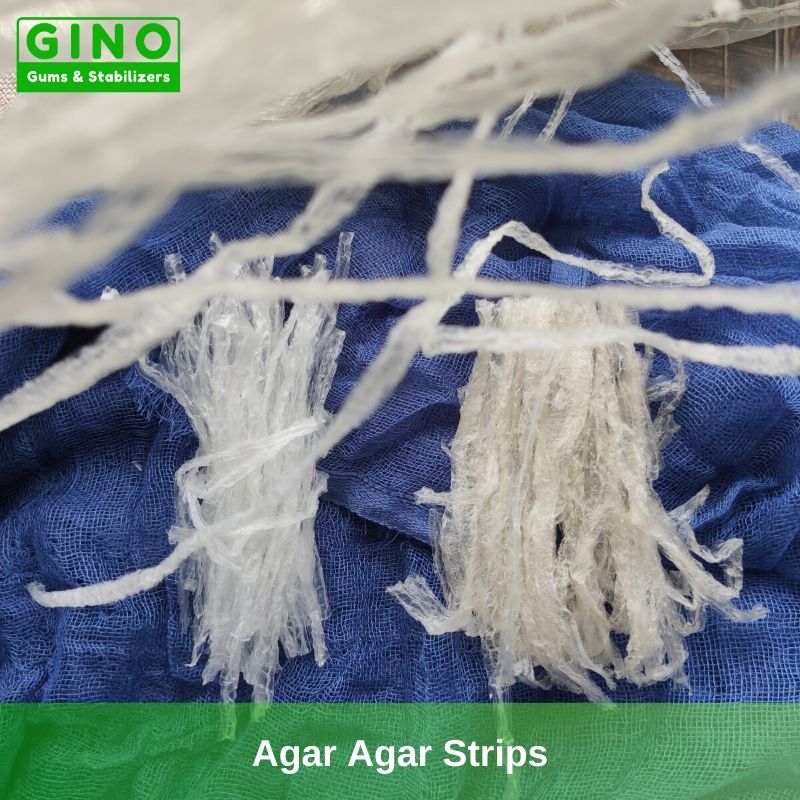
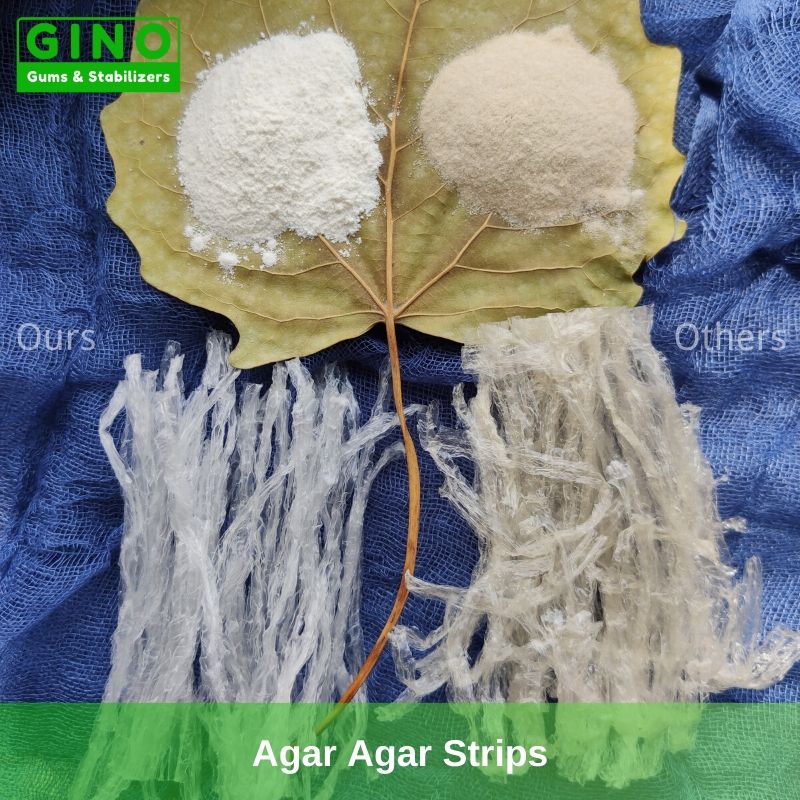
Tiras de ágar-ágar
| Categoria | Espessantes, estabilizadores |
|---|---|
| E Número | E406 |
| N.º CAS | 9000-70-8 |
| Código H.S. | 1302310000 |
| Origem | China |
| QUANTIDADE MÁXIMA DE ENCOMENDA | 500 KG |
| Embalagem | Caixas de cartão, sacos, tambores |
| Prazo de pagamento | T/T, L/C |
GINO_O seu principal fabricante de ágar-ágar
De que é feito o ágar-ágar?
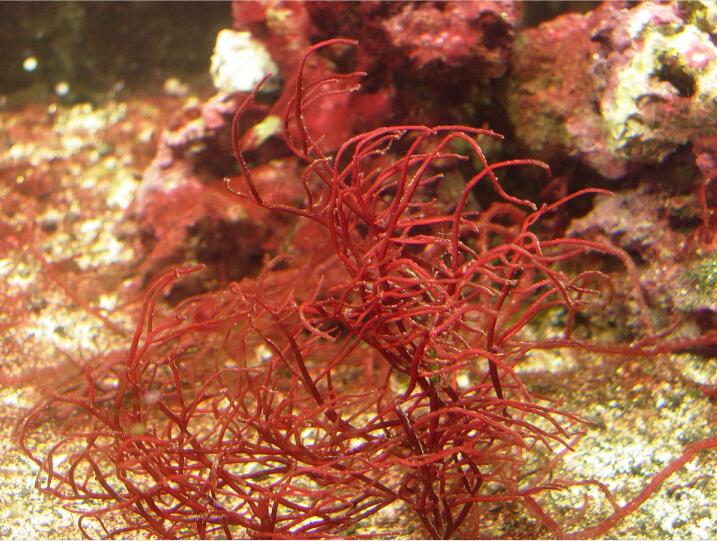
- Matérias-primas
De onde é obtido o ágar-ágar?
Trata-se de uma família de polissacáridos galactânicos lineares obtidos a partir das paredes celulares das algas vermelhas, sendo o Gelidium e a Gracilaria as principais espécies utilizadas para a produção comercial de ágar.
As espécies Gelidium foram os materiais originalmente utilizados no Japão, mas a escassez durante a Segunda Guerra Mundial levou à descoberta de que as espécies Gracilaria eram adequadas se as algas fossem tratadas com álcalis durante a transformação.
Fluxograma de produção
Tiras de ágar
Gracilaria (ou Geldium) → Lixiviação alcalina → Lavagem → Branqueamento → Gel em ebulição → Filtragem → Tiras de empurrar → Congelação → Desidratação → Secagem → Produto acabado → Embalagem.
A nossa gama de produtos
Poderá desfrutar de todos os tipos e formas de produtos de ágar, incluindo:
Ficha de especificações
| Caraterísticas sensoriais | |
| Aparência | Apresenta-se em tiras, com uma cor ligeiramente esbranquiçada e um odor e sabor neutros. |
| Caraterísticas químicas e físicas | |
| Humidade | ≤12% |
| Cinza total | ≤5% |
| Resistência do gel (Método Nikkan) | 500-700 g/cm2 |
| Ph | 5-7 |
| Amido Dextrina | Não detetável |
| Gelatina e outras proteínas | Não detetável |
| Matéria insolúvel em água | ≤15% |
| Metal pesado | ≤1 Ppm |
| Cinzas insolúveis em ácido | ≤0,5 % |
| Caraterísticas microbiológicas | |
| Contagem total de placas | Máximo 5000 CFU/g |
| Leveduras e bolores | Máximo 300 CFU/g |
| E.Coli | Ausente em 5g |
| Salmonela | Ausente em 5g |
Observações:
A ficha de especificações destina-se apenas a orientação e referência. Os resultados do cliente podem ser diferentes devido a variações nas condições de ensaio, equipamento e métodos.
As nossas embalagens
Como um dos fabricantes profissionais e responsáveis de ágar-ágar, para além de lhe fornecer produtos de qualidade, também tentamos o nosso melhor para lhe oferecer soluções de embalagem flexíveis, para lhe fornecer embalagens personalizadas, e o nosso objetivo é simples, apenas para:
- Construir seu marca sentido e desenvolver o seu privado marca
- Promova a sua própria imagem de marca.
- Dê um impulso aos seus esforços de marketing promocional.
- Faça-o destacar-se da sua concorrência.
10 g Neutro 20 g Fita vermelha 10-1000 g Marca própria 10 Kg Neutro
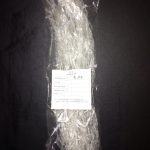
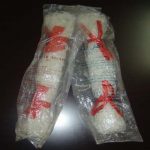
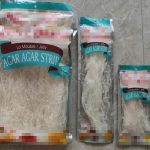
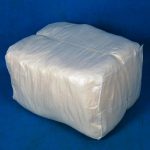
Carregamento e entrega e expedição
Irá gostar:
Uma variedade de estilos de embalagem, métodos de carregamento flexíveis, pequenas quantidades de encomenda, prazo de entrega rápido ...
| Quantidade de carga | |||
| Embalagem | Contentor | Quantidade | Peso líquido |
| Saco tecido 10 Kg Pp | 1*20' FCL | 250 sacos | 2.500 Kgs |
| Saco de plástico de 10 g | 250 sacos= 250 fardos * | 1,200 Kgs | |
| Saco de plástico de 20 g | 250 sacos= 250 fardos * | 1,200 Kgs | |
| Prazo de entrega | |||
| Embalagem de 10 kg a granel | No prazo de 2-3 semanas após o pré-pagamento | ||
| Pequenas embalagens para retalho | No prazo de 4-6 semanas após o pré-pagamento | ||
Observações:
- Se um saco de plástico de 10 g, 1 feixe =10 g * (400-500)=4,0-5,0 kgs;
- Se for um saco de plástico de 20 g, 1 pacote =20 g * (200-250)=4,0-5,0 kgs.
- Desde a conceção da embalagem, seleção do material de embalagem e impressão da embalagem até à embalagem manual, entrega, tudo num único serviço de embalagem.
Escolhemos apenas companhias de navegação de renome para garantir segurança e tempo. Desde o nosso armazém até ao porto de destino, ou mesmo até ao seu armazém, o "Full Tracking Service" está sempre consigo.
Ágar-ágar Propriedade
As caraterísticas mais importantes do ágar-ágar são as seguintes
Grande poder gelificante
O seu grande poder gelificante em meio aquoso permite-lhe formar géis mais resistentes (mais fortes) do que os de qualquer outro agente gelificante, admitindo a utilização de concentrações iguais.
Não são necessários reagentes
A simples solução aquosa tem esse poder gelificante. Não é necessário adicionar reagentes para produzir gelificação, tais como potássio (ou proteínas, como é necessário com as carrageninas), cálcio (ou outros catiões divalentes, como é necessário com os alginatos). Não são necessárias concentrações elevadas de açúcar ou um ambiente ácido (como é necessário com as pectinas).
Ampla gama de pH
Pode ser utilizado numa vasta gama de pH, de 5 a 8, e em alguns casos para além destes limites. Resiste muito bem aos tratamentos térmicos, mesmo acima de 100°C, o que permite uma boa esterilização.
Histerese do gel
Uma solução aquosa de 1,5% gelifica entre 32°C-43°C e não derrete abaixo de 85°C. Esta é uma propriedade única do ágar, em comparação com outros agentes gelificantes.
Sem adição de catiões
O ágar dá géis sem sabor e não necessita da adição de catiões com sabores fortes (potássio ou cálcio), podendo ser utilizado sem problemas para gelificar produtos alimentares com sabores suaves.
Realça os sabores
Assimila e realça os aromas dos produtos com ele misturados e actua como fixador de fragrâncias, permitindo a sua fixação a longo prazo.
Gel termoreversível
O seu gel tem uma excelente reversibilidade que lhe permite ser repetidamente gelificado e fundido sem perder nenhuma das propriedades originais.
Géis transparentes
Os géis transparentes e facilmente coloridos podem ser obtidos; o seu índice de refração também pode ser facilmente aumentado através da adição de açúcar, glucose, glicerina, etc., dando-lhes um brilho atrativo.
Benefícios do ágar-ágar
Saudável
Desempenho do gel
Vegan
Utilização em laboratório
Agar Applications - Utilizações do Agar
1. Aplicações alimentares
O ágar-ágar foi o primeiro hidrocolóide a ser utilizado na indústria alimentar humana. No início, era apenas utilizado no Extremo Oriente, mas as aplicações têm-se estendido a todo o mundo há mais de um século.
O FAO/OMS O Codex Alimentarius permite a utilização de ágar-ágar na indústria alimentar humana e foi também aceite e autorizado pelos regulamentos dos países mais exigentes, como o Reino Unido, a República Federal da Alemanha, a Rússia, a França e a Polónia. A Food and Drug Administration (FDA) dos Estados Unidos atribui ao ágar-ágar a classificação de GRAS (Generally Recognised as Safe).
Na indústria alimentar humana, o ágar é utilizado principalmente como agente gelificante e, secundariamente, como agente estabilizador e para controlar a viscosidade. É utilizado como aditivo e não como nutriente. O poder gelificante do ágar é tão elevado que é utilizado numa concentração máxima de 1%; para o controlo da viscosidade e como agente estabilizador, a proporção utilizada é de 1/100 ou menos. Por este motivo, as quantidades ingeridas são muito reduzidas e, uma vez que o ágar não é facilmente digerido pelo organismo humano, a sua contribuição calórica é negligenciável, pelo que o ágar pode ser utilizado em alimentos de dieta especial.
As aplicações do ágar na indústria alimentar baseiam-se nas suas caraterísticas especiais e as aplicações mais importantes são as seguintes.
Geleia de ágar, sobremesa de água gelatinas, Confeitaria, Produtos de panificação, Produtos lácteos, Produtos fermentados, Conservas carne e produtos da pesca, Sopas e molhos, Agente de revestimentoe Alimentos saudáveis.
2. Aplicações não alimentares
Meios de cultura e outros aplicações bacteriológicas, Cultura de tecidos de plantasMoldes dentários e preparações farmacêuticas.
Ágar em microbiologia:
As suas utilizações em microbiologia baseiam-se em propriedades especiais: uma temperatura de gelificação de 32-36°C, uma temperatura de fusão de 85-86°C, uma ausência de hidrólise por exoenzimas bacterianas e a sua capacidade de ser preparado sem inibidores bacterianos. As temperaturas acima referidas referem-se a meios de cultura gelificados com ágar e que contêm 10-11 g de ágar por litro de meio de cultura.
Ágar em Biologia:
Pode perguntar-se: Porque é que o ágar é utilizado para cultivar bactérias?
A utilização de ágar em bacteriologia é uma das utilizações mais importantes e exige um controlo físico-químico rigoroso, bem como a ausência de substâncias hemolíticas e, o que é mais importante e difícil, a ausência de quaisquer inibidores bacterianos. Robert Koch começou a utilizar o ágar em 1881 para gelificar caldos de cultura aquando da preparação de meios de cultura sólidos, tendo sido esta a primeira introdução deste produto oriental na Europa.
Ágar em Farmácia:
A aplicação do ágar-ágar em farmácia como laxante suave é bem conhecida. Ultimamente, tem sido utilizado como excipiente em preparações farmacêuticas. Em alguns países ocidentais, o ágar é utilizado como antirreumático, uma vez que um tratamento prolongado permitiu melhorias importantes na saúde dos pacientes. O ágar tem sido utilizado para estabilizar soluções de colesterol.
- Produtos relacionados
- Formulário de contacto
Concentramos a nossa principal atenção em vários tipos de hidrocolóides e sistemas estabilizadores de alta qualidade.
Precisa de encontrar fabricantes, fornecedores e exportadores fiáveis de E406 Agar Agar na China? Como uma empresa de ágar, todos os tipos e formas de produtos de ágar podem ser fornecidos pela Gino. Podemos ajudá-lo a encontrar o ágar perfeito para a sua aplicação.
Preencha os campos abaixo para obter o preço mais recente do ágar a granel por grosso.

